Overview
Protecting the United States from incoming bombers was the primary mission of the ADC in the early years of the Cold War, and airborne interceptors made up a significant portion of that Command. Initially these were converted day fighters like the F-86D and F-94, with only one purpose-built interceptor, the F-89, being developed from the ground up for this role. All of these early interceptors were subsonic, though, and the need for a supersonic interceptor was high on the priority list. Convair's work with delta-wing aircraft resulted in their entry into the ADC interceptor realm with the F-102A Delta Dagger.
The F-102 was the first operational interceptor to take advantage of area rule, the pinched fuselage appearance that became common in aircraft design for decades to come. Additionally, it was the first supersonic interceptor for the US, and it quickly filled the ranks of both the ADC and ANG. Both Greece and Turkey also purchased the aircraft, and the F-102 saw combat during Vietnam.
The Kit
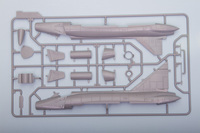 For such a colorful aircraft, it is surprising that we haven't seen more kits of the F-102. In 1/72, there is only one, the ancient Hasegawa kit, which was not too bad when it first came out. However, it first came out over 40 years ago, so it's not hard to surmise that it doesn't stand up to today's models. So when Meng had announced a new-tool F-102A in 1/72, modelers around the globe rejoiced, and the parenthetical reference on the boxtop to Case X suggested that they did their homework as well.
For such a colorful aircraft, it is surprising that we haven't seen more kits of the F-102. In 1/72, there is only one, the ancient Hasegawa kit, which was not too bad when it first came out. However, it first came out over 40 years ago, so it's not hard to surmise that it doesn't stand up to today's models. So when Meng had announced a new-tool F-102A in 1/72, modelers around the globe rejoiced, and the parenthetical reference on the boxtop to Case X suggested that they did their homework as well.
A bit of a background on that Case X nomenclature is probably welcome here. The F-102 underwent several aerodynamic design changes throughout its operational career. The first operational F-102 had that easily identifiable short tail, but it also had intakes with no splitter plates. Stability issues resulted in the taller fin, and the intake splitter plates were added to improve airflow, resulting in the standard F-102 Case X (that's Ten, by the way). There was also a more subtle change that is not as readily apparent in that the main landing gear was angled two degrees. This made for a big improvement in minimum takeoff speed, especially with the Case X wing as it had smaller elevons.
The Case XX wing differed from the Case X wing in that the camber continued on out to the wingtip, rather than transitioning to a reflexed wingtip as seen on the Case X wing. This improved overall handling across the flight envelope, as well as gave a slight increase in top speed and maximum altitude, but at a reduction in range. The Case XX wing was standard on all F-102s from 56-1317 onward, and was not retrofitted. So check your serial numbers to see whether you need a Case X or Case XX kit. Given how the Meng kit is engineered, we will see a Case XX release before too long.
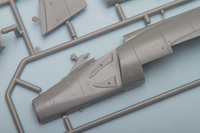 Back to the plastic, the kit comes molded in gray plastic with recessed panel lines, optional open or closed weapon bay and airbrakes, a detailed cockpit, and external drop tanks. The decal sheet offers three aircraft options, and unlike some of the Hasegawa kits, this one actually has all the options designed for the Case X F-102. Overall first impressions are that this is going to be a great kit.
Back to the plastic, the kit comes molded in gray plastic with recessed panel lines, optional open or closed weapon bay and airbrakes, a detailed cockpit, and external drop tanks. The decal sheet offers three aircraft options, and unlike some of the Hasegawa kits, this one actually has all the options designed for the Case X F-102. Overall first impressions are that this is going to be a great kit.
Jumping into the construction, we start with the cockpit. Having built the Hasegawa kit ages ago, I know that if you choose to build an F-102 with the canopy closed, you really don't need much on the inside as very little can be seen. With the canopy open, there is more visible, but it is still a very tight office. This kit provides a very good interior, though, with the ejection seat comprising of three pieces, a separate instrument panel and control stick, and a cockpit tub that includes the overhead area behind the seat. The instrument panel and side consoles both feature raised detail, and the sidewalls in the fuselage halves are thinned down for a more accurate rendition.
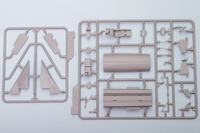 The next step in the instructions cover the landing gear. Here is another area that reflects some changes between F-102s: the nose wheel. This kit comes with the spoked nose wheel, while some F-102s featured a nose wheel with closely spaced ribs. I am not sure when that ribbed nose wheel appeared, but perhaps we will see that on the Case XX sprue when that version is released. The gear struts themselves are well done, with both the nose gear and main gear legs featuring separate oleo scissors. The mounting supports look quite sturdy as well.
The next step in the instructions cover the landing gear. Here is another area that reflects some changes between F-102s: the nose wheel. This kit comes with the spoked nose wheel, while some F-102s featured a nose wheel with closely spaced ribs. I am not sure when that ribbed nose wheel appeared, but perhaps we will see that on the Case XX sprue when that version is released. The gear struts themselves are well done, with both the nose gear and main gear legs featuring separate oleo scissors. The mounting supports look quite sturdy as well.
Attention now turns to the fuselage assembly. The engine exhaust bits are very nicely done, with a separate two-piece pipe matching up to a rear bulkhead that features the engine exhaust face. On the other end is a very detailed two-part afterburner attenuator, and this assembly then fits between the two fuselage halves. On the front end, the completed cockpit tub sits atop the nose gear well, and with those in place, the fuselage halves can be buttoned up.
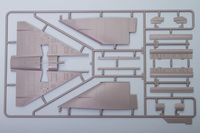 For the wing, this is split into separate right and left upper halves, with a solid lower piece that includes the lower fuselage bits. This includes the missile bay, which is provided as a separate piece. Also separate is the main gear well, which fits into the fuselage assembly. This engineering should help ensure that the fuselage is properly spaced when you add the wings. As noted the wings have separate wingtip and elevon pieces to cover the Case X differences, and these are carefully engineered to minimize seam work. Namely, the upper portion butts up against the wing fence, so with some careful test fitting this assembly should result in no filler needed.
For the wing, this is split into separate right and left upper halves, with a solid lower piece that includes the lower fuselage bits. This includes the missile bay, which is provided as a separate piece. Also separate is the main gear well, which fits into the fuselage assembly. This engineering should help ensure that the fuselage is properly spaced when you add the wings. As noted the wings have separate wingtip and elevon pieces to cover the Case X differences, and these are carefully engineered to minimize seam work. Namely, the upper portion butts up against the wing fence, so with some careful test fitting this assembly should result in no filler needed.
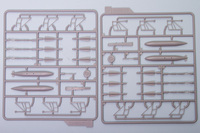 The air brakes at the base of the vertical fin can be displayed open or closed, with detailed actuator struts provided. On the underside, separate details include the arrestor hook, detailed landing gear doors, and a separate nose door landing light. The drop tanks are nicely done and are the first I've seen in this scale that accurately depict the small fins found on them. A one-piece insert is provided for those who want their Deuce displayed with the missile bay closed.
The air brakes at the base of the vertical fin can be displayed open or closed, with detailed actuator struts provided. On the underside, separate details include the arrestor hook, detailed landing gear doors, and a separate nose door landing light. The drop tanks are nicely done and are the first I've seen in this scale that accurately depict the small fins found on them. A one-piece insert is provided for those who want their Deuce displayed with the missile bay closed.
For those who want the missile bay open, there are two options: missiles extended or missiles retracted. All the requisite strutwork is provided, and the open doors are very nicely detailed, including the in-door FFAR rocket tubes. Lastly, the nose cone is separate, with a separate pitot tube, and there is an optional IR sensor should you be modeling an F-102 that featured one of those.
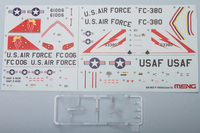 For markings, the kit comes with three schemes. Two are in the ADC gray color scheme, with the third being in the SEA camouflage. First up is the boxtop scheme, an F-102A from the 431st Fighter Interceptor Squadron in 1962. This scheme features the colorful devil's head on the tail in a red band, with fuselage stripes and colorful air brake markings. The second option is from the 327th FIS in 1958, and has the vertical fin painted in white with red lightning bolts. This scheme has the odd curved U.S. AIR FORCE on the fuselage side, with the small star and bar on the nose. Finally we have the camouflaged F-102A from the 497th FIS in 1970. Minimal markings on this one, with just the serial number in black and a white 18 higher up on the fin. The decals look to be quite good, and undoubtedly we will see a flood of aftermarket decals before too long.
For markings, the kit comes with three schemes. Two are in the ADC gray color scheme, with the third being in the SEA camouflage. First up is the boxtop scheme, an F-102A from the 431st Fighter Interceptor Squadron in 1962. This scheme features the colorful devil's head on the tail in a red band, with fuselage stripes and colorful air brake markings. The second option is from the 327th FIS in 1958, and has the vertical fin painted in white with red lightning bolts. This scheme has the odd curved U.S. AIR FORCE on the fuselage side, with the small star and bar on the nose. Finally we have the camouflaged F-102A from the 497th FIS in 1970. Minimal markings on this one, with just the serial number in black and a white 18 higher up on the fin. The decals look to be quite good, and undoubtedly we will see a flood of aftermarket decals before too long.
Conclusion
This kit definitely lives up to its potential. Those of us who build 1/72 finally have an F-102 kit worthy of the scale, and I am really looking forward to seeing the Case XX release. And perhaps a bit of wishful thinking, I would love to see a TF-102 as well. Regardless, I foresee many Deuces on the shelf here, as it would take half a dozen just to build the ones that served in my home state. My thanks to Stevens International for the review sample.